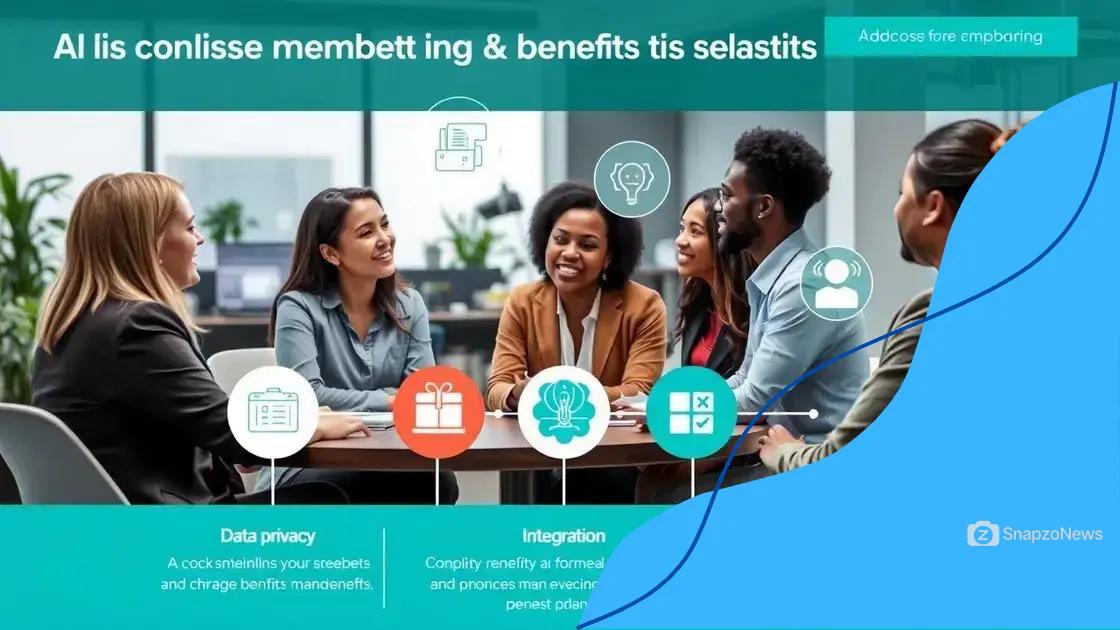AI’s influence on benefits management: Transform your strategy

AI’s influence on benefits management enhances personalization, streamlines processes through automation, and leverages predictive analytics to meet employee needs effectively, leading to increased satisfaction and engagement.
AI’s influence on benefits management is reshaping how companies approach employee support. Have you ever wondered how this technology can enhance workplace satisfaction? Let’s dive into its transformative potential.
Understanding AI in benefits management
Understanding AI in benefits management is crucial for modern businesses. As companies look for ways to enhance employee satisfaction, AI offers innovative solutions that can change the game.
What is AI?
Artificial Intelligence, or AI, involves machines that can perform tasks that typically require human intelligence. These tasks include problem-solving, understanding natural language, and learning from experiences. In the realm of benefits management, AI helps automate processes and provide insights that were previously unattainable.
Benefits of AI in Benefits Management
Using AI in benefits management allows employers to tailor offerings to meet employee needs more effectively. For instance, AI can analyze employee preferences and engagement patterns. This leads to more personalized benefits, which can improve overall morale.
- Improved data analysis for better decision-making
- Streamlined administrative tasks
- Increased employee engagement
- Personalized benefits solutions
Moreover, AI can assist in predicting trends based on historical data. By identifying patterns, companies can proactively adjust their benefits strategies. This agility ensures that organizations not only attract talent but also retain it.
AI tools can simplify the enrollment process, making it easier for employees to understand their options. A guided interface, powered by AI, can provide suggestions based on an individual’s role or previous selections, making the process more user-friendly.
Challenges to Consider
However, integrating AI into benefits management isn’t without challenges. There can be concerns regarding data privacy and security. Organizations must ensure that employee data is handled responsibly and that privacy regulations are adhered to.
Furthermore, there is a learning curve associated with implementing AI systems, which may require training for both HR personnel and employees. Despite these challenges, the benefits of adopting AI far outweigh the hurdles, and many organizations are successfully navigating these obstacles.
As we continue to explore AI’s influence on benefits management, it becomes clear that understanding this technology is the first step toward harnessing its potential. The path forward involves not just adopting AI, but embracing a culture that acknowledges its impact and appreciates its capabilities.
Key advantages of AI implementation
Exploring the key advantages of AI implementation in benefits management reveals numerous opportunities for businesses. Companies that adopt AI technologies can streamline operations while improving employee satisfaction.
Enhanced Efficiency
AI automates routine and repetitive tasks, allowing HR professionals to focus on more strategic initiatives. For example, enrollment processes can be simplified, cutting down the time spent on paperwork. This automation not only saves time but also reduces the likelihood of errors.
- Automation of routine tasks
- Faster data processing
- Reduction in administrative errors
- Improved resource allocation
As AI systems learn and adapt, they can continuously improve efficiency. By analyzing employee interactions and preferences, these systems can recommend personalized benefits, thereby increasing user satisfaction.
Data-Driven Insights
Another significant advantage of AI is its ability to provide deep data-driven insights. By analyzing vast amounts of information, AI can uncover trends and patterns that would be nearly impossible for humans to identify. This capability allows organizations to make informed decisions that align with employee needs.
For example, AI can identify which benefits are most valued by employees, allowing HR to focus on those that drive engagement. Furthermore, organizations can utilize predictive analytics to anticipate future needs based on current trends.
Improved Employee Engagement
Implementing AI can significantly boost employee engagement. A well-designed AI system can offer personalized recommendations, ensuring that employees receive benefits relevant to their individual situations. When employees feel valued through customized options, they are more likely to engage fully in their roles.
Additionally, AI can facilitate continuous feedback mechanisms, providing insights into employee satisfaction and helping managers address concerns promptly.
By leveraging AI in benefits management, businesses can create a more dynamic and responsive workplace that fosters engagement and productivity. This innovative approach not only enhances the working environment but also aligns with the evolving expectations of the modern workforce.
Challenges in adopting AI for benefits management

Adopting AI for benefits management presents several challenges that organizations must navigate carefully. While the advantages are compelling, understanding the obstacles is crucial for successful implementation.
Data Privacy Concerns
One of the primary challenges is maintaining data privacy. Organizations handle sensitive employee information that must be protected. As AI systems process and analyze this data, there is a risk of breaches if proper security measures are not in place.
- Compliance with laws like GDPR
- Ensuring secure data storage
- Training staff on data protection
- Regular audits of AI systems
To overcome these concerns, businesses must implement rigorous data governance policies that safeguard employee information while allowing AI to function effectively.
Integration with Existing Systems
Another challenge is integrating AI tools with existing HR systems. Many organizations rely on legacy systems that may not be compatible with new AI technologies. This incompatibility can create barriers to effective implementation.
Successful integration requires careful planning, including:
- Assessing current systems
- Identifying gaps and required updates
- Collaborating with IT for smooth transitions
- Testing new AI solutions before full-scale deployment
By taking these steps, organizations can ensure a seamless transition to AI-enhanced benefits management.
Change Management
Implementing AI also involves addressing cultural resistance within the workplace. Employees may be apprehensive about adopting new technologies, fearing job displacement or loss of control over their benefits management.
To mitigate these fears, companies should focus on open communication and education. Providing training sessions and demonstrating how AI can enhance rather than replace roles will help ease this transition.
Moreover, engaging employees in the adoption process can foster a sense of ownership and acceptance. As businesses work through these challenges, they will pave the way for a more efficient and employee-friendly benefits management system.
Real-world examples of AI impact
Real-world examples of AI impact on benefits management highlight how companies leverage technology to transform their approaches. Several organizations have embraced AI tools, yielding impressive results.
Company A: Personalized Benefits
One notable example is Company A, which implemented an AI system to analyze employee data. By examining preferences and usage patterns, the company was able to offer personalized benefits packages. As a result, employee satisfaction increased significantly.
- Customized health plans based on individual needs
- Targeted wellness programs
- Personalized financial advice
This tailored approach not only boosted morale but also improved retention rates, showing how adapting benefits to individual preferences can be a game-changer.
Company B: Streamlined Enrollment Processes
Another powerful example comes from Company B, which focused on streamlining their enrollment process through AI. By automating the benefits selection, employees could quickly and easily choose their options without getting overwhelmed by too much information.
They also introduced a chatbot that guided employees through the enrollment process, answering questions in real-time. This innovation led to higher participation in available programs.
Company C: Enhanced Data Analysis
Company C utilized AI to enhance data analysis capabilities. By collecting and analyzing vast amounts of employee data, they were able to make informed decisions about which benefits to offer based on current employee needs and future trends.
This proactive approach enabled the company to remain competitive in attracting top talent. Staff engagement improved, as employees felt their needs were being acknowledged and met.
Each of these real-world examples demonstrates how AI can drive positive change in benefits management. By leveraging technology, organizations can enhance employee experiences, streamline processes, and ultimately improve overall satisfaction within the workplace.
Future trends in AI and benefits management
Future trends in AI and benefits management promise to reshape how organizations engage with their employees. As technology continues to advance, the integration of AI in benefits management is expected to grow, providing more sophisticated tools and solutions.
Increased Personalization
One key trend is the move towards increased personalization. AI technologies will analyze employee data to create highly tailored benefits packages. Such customization can enhance employee satisfaction and retention, as benefits will be aligned closely with individual preferences and needs.
- Behavior-based recommendations
- Dynamic benefits offerings
- Proactive health and wellness support
This personalized approach not only makes employees feel valued but also encourages them to utilize available benefits more effectively.
Predictive Analytics for Strategic Decisions
Predictive analytics is another significant trend shaping the future of benefits management. By using historical data, AI can forecast future trends, allowing organizations to anticipate employee needs.
Employers can analyze metrics such as utilization rates and employee feedback, which can guide them in making decisions about which benefits to expand or modify. This strategic foresight helps ensure that organizations stay ahead of changes in the workforce.
Seamless Integration with Emerging Technologies
As new technologies emerge, the integration of AI with these platforms will become essential. For example, connecting AI tools with health and wellness apps will allow for a more cohesive approach to employee benefits.
Employees can access their benefits information and health resources in one place, making it easier to manage and use their offerings effectively. This seamless integration enhances the overall user experience, encouraging higher engagement levels.
In summary, the future of AI in benefits management looks promising. With trends emphasizing personalization, predictive analytics, and integration, organizations will be better equipped to meet the evolving needs of their workforce. This dynamic landscape will ultimately lead to improved employee satisfaction and organizational success.
In conclusion, the integration of AI in benefits management is paving the way for a promising future. With advancements in personalization, predictive analytics, and seamless integration of new technologies, organizations are equipped to meet the evolving needs of their workforce. As companies embrace these changes, they can improve employee satisfaction and drive overall success. Keeping informed about these trends will help businesses maintain a competitive edge and foster a more engaged, productive workplace.
FAQ – Frequently Asked Questions about AI in Benefits Management
How does AI help personalize benefits packages?
AI analyzes employee data to create customized benefits packages tailored to individual preferences, enhancing employee satisfaction.
What are predictive analytics, and how can they benefit my organization?
Predictive analytics use historical data to forecast trends and anticipate employee needs, allowing for more informed decision-making about benefits.
How can AI improve employee engagement?
AI can provide personalized recommendations and streamline access to benefits, making employees feel valued and involved in their benefits management.
What are some challenges of implementing AI in benefits management?
Challenges include ensuring data privacy, integrating with existing systems, and managing change within the organization.
